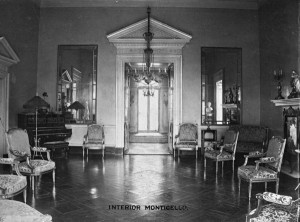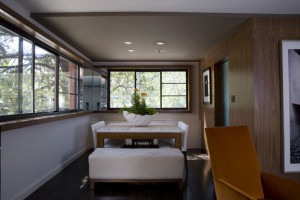Bases, Casings and Mouldings-Just Why?
Written by Spencer McNeil on February 26th, 2013 // Filed under Uncategorized
For years, applied trim was a given on all my interior projects. By trim, I am referring to base moulding, crown moulding, window and door casing, etc. It was was selected and specified from a catalogue, except in those projects where we created custom profiles. Trim is available in hundreds of shapes and sizes, which when combined or modified, expands the possibilities exponentially.
Trim serves an architectural purpose, with origins that trace back to Classic Greek Architecture. Used effectively, it gives a room scale, enhances doors and openings and reinforces the geometry of a room.

The interior of San Giorgio Maggiore in Venice by Renaissance Master Andrea Palladio illustrates the perfect use of moulding in accordance with the Corinthian style of Architecture, executed in stone and plaster.
Palladio influenced the work of Thomas Jefferson, who designed his home, Monticello, in Charlottesville, Virginia.

The exterior of Monticello, influenced by Palladio’s Villa Rotonda, executed in brick, stone and wood.

Classically inspired and beautifully proportioned, this parlor is one of the most formal rooms at Monticello. The use of trim is integral to the architecture of the room.
Copying is copying no matter how you phrase it and somewhere along the line of copying, the original intent of architectural mouldings has been lost to where moulding is used to cover up sloppy construction and in many cases, serve no purpose other than to provide what is expected.
In Washington, DC, what is known as “traditional” residential architecture comprises most of what was built through the end of the 20th century. In my work, I’ve encountered situations where moulding is poorly used and comprises a distraction. But alas, there is hope.

BEFORE
This home, built in the 1990’s has an open plan first floor, sported snap on window mullions, a stock wood mantlepiece, crown moulding and window casing, which is barely visible in this photo.
AFTER

Some mouldings were kept intact and new trim was installed around the windows to emphasize the height. The mantlepiece was replaced with a simple, contemporary surround to create a strong focal point in the space. I refer to this type of work as a soft remodel: one step beyond cosmetic, where no structural, mechanical or plumbing work is involved. The changes are specifically geared to enhance the quality of the space.
Here’s an example where the moulding was replaced.

BEFORE
Notice there is a small crown moulding that follows the outline of the space. There is also a wood window sill.

Walnut trim was used to unify the two sets of windows and emphasized by mirror. Notice the walnut paneling has not trim, which means it had to fit perfectly.
Architectural trim serves a purpose. The question is, what purpose is it being used for?
